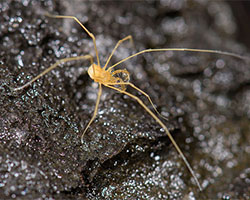There's a Spider Next to You! (Probably)
Arachnid researcher Marshal Hedin talks about dodging moonshiners and braving bites to learn more about our fascinating eight-legged friends.

The Curious Aztec takes you behind the scenes of scientific investigation and discovery taking place at San Diego State University. This month, we're exploring the creepier, crawlier side of our research.
If you’re reading this anywhere outside on campus at San Diego State University, don’t look now, but there’s a spider under your bench. Or on the windowsill. Or in the corner, the stairwell, or the bushes. The fact is, spiders—especially Latrodectus geometricus, the brown widow—are pretty much everywhere in this part of San Diego.
“Any bench that you sit on or bike rack where you park your bike on campus, there’s going to be some brown widows under there,” said biologist Marshal Hedin, SDSU’s resident arachnid expert. “Most people wouldn’t suspect that, I guess.”
Hedin has studied spiders and other arachnids at SDSU since 1999. His lab sports a Spider-Man poster on its door, and a couple of pet spiders inside, including a tarantula and a jumping spider. His office is decorated with spider drawings and photographs. Many are brilliantly colored and quite beautiful if you can get past your initial squeamishness.
He didn’t set out to study spiders. While Hedin was working on his Ph.D. in biology at Washington University in St. Louis, Missouri, he initially wanted to study salamanders. But that research wasn’t panning out, so he started looking into what his arachnid-researching colleagues down the hall were studying. Their work sounded cool to Hedin, so he switched his dissertation topic to a nearby genus of spiders known as Appalachian cave spiders and never looked back.
Spider tripping
His research took him around the country looking for new and little-known species. In the Ozarks, he stayed in a lonely cabin in the woods for weeks at a time.
“I was collecting night and day in the middle of summer, crawling around on my hands and knees,” Hedin recalled.
While investigating caves in Appalachia, he would occasionally be turned away by moonshiners using the hollows to hide their stills.
He’s been bitten, naturally. One would expect as much from a spider researcher. Most frequently, the bites have come courtesy of Calisoga longitarsis, the Californian velveteen tarantula, known as one of the most aggressive spiders around. Luckily, its bite isn’t particularly dangerous to humans. Also luckily, the one time he mistakenly picked up an Australian funnel-web spider—among the most deadly in the world—it didn’t bite him.
“I just wasn’t paying attention to what kind of spider it was,” Hedin said. “I was just grabbing stuff that I saw. I do that sometimes.”
Despite these encounters, Hedin considers mygalomorph spiders, which include tarantulas, trapdoor spiders and funnel-webs, to be his favorites. They’re interesting to study, he said, because they don’t migrate very far, leading to many closely related yet genetically distinct species within a small area. One of the least favorite parts of his job is that in order to properly study many of these spiders, he has to trap and kill the creatures he’s come to admire.
“I’ve killed plenty of trapdoor spiders in my research,” Hedin said. “That always kind of bums me out.”
Like spiders, but not spiders

More recently, Hedin’s attention has shifted toward harvestmen (or as you might know them, "daddy longlegs"—a term that can refer to several different kinds of harvestment). These arachnids look like spiders to the untrained eye, but there are some key differences. They don’t build webs, there’s no clear distinction between their thorax and abdomen, and male harvestmen have penises (male spiders do not).
Relative to spiders, harvestmen are understudied, yet they share an equally important role in our ecosystem. To shine more light on these organisms, the National Science Foundation recently awarded Hedin $500,000 over three years to find new species of harvestmen and further describe known species.
Hedin hopes that the work he’s doing will inspire greater public understanding of arachnids and their place in our lives. Far from nightmarish monsters, these critters are critical to a healthy ecosystem and are far less dangerous than is commonly believed.
“Most people think that spiders are bad and harmful,” Hedin said. “But there are something like 100,000 spider species, and maybe only 20 or 30 are medically dangerous. And most of those aren’t life-threatening. Most spiders are just out there doing their thing, with considerable ecological importance. They’re clearly more beneficial than harmful.”


